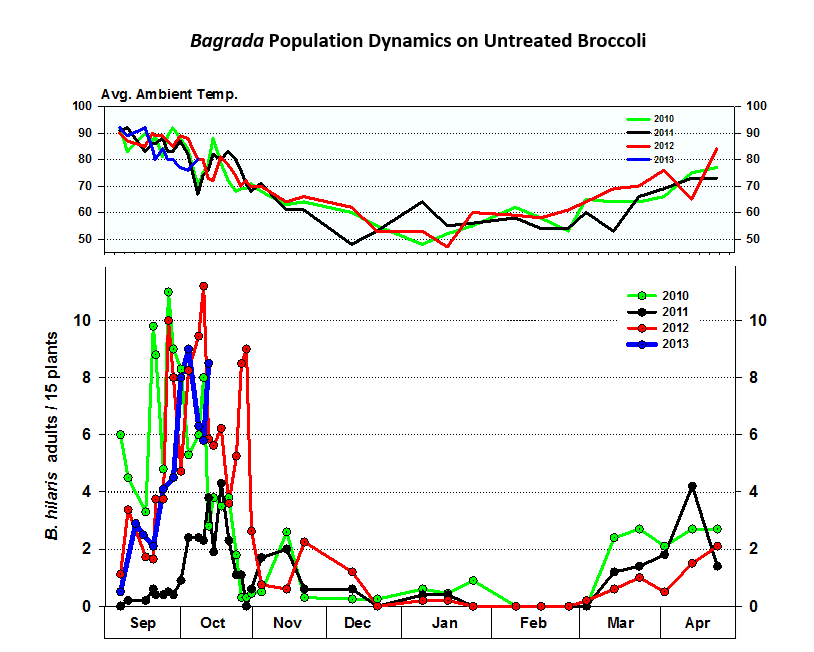
|
|
|
|

|
|||
|
|
|||
|
The recent break in the weather suggested to me that insect activity in general should begin to significantly decline throughout the region. For instance, in the Yuma Valley during the past 10 days temperatures have been on average about 7 degrees cooler than normal and particularly the nighttime temperatures which have been as much as 12 degrees cooler. However, based on insect activity we’re observing in our experimental plots here at the Yuma Ag Center (YAC), as well as reports from PCAs - this is not the case. In September whitefly, beet armyworm and bagrada bug activity was heavy in most areas. We saw a small decline in whitefly activity following the rains we had a month ago, but adults are still actively moving in some areas. Here at YAC, whiteflies on untreated melons are causing significant plant mortality from heavy immature colonies and CYSDV. Beet armyworm pressure started heavy in September and remains heavy in our untreated blocks. We’re still observing overlapping egg lays of both egg masses and cabbage looper eggs. As is typical, cabbage loopers are very active now, as witnessed by large larval populations in our plots and an area wide increase in trap captures of moths (see Area Trap Network). We’re also beginning to pick up a significant increase in leafminer activity on untreated lettuce plots which is consistent with this time of the year. Bagrada bug have been heavy this year and pressure remains high in experimental plots at YAC (see Graph below). Their movement has not yet subsided, as reports are coming in from PCAs that they are still actively battling Bagrada in cole crops, especially in Bard, and the Gila and Yuma Valleys. A new planting of broccoli this week (Oct 10) at YAC was heavily infested with adults upon plant emergence. On our older plantings, nymph and adult populations are widespread. Based on past experience, we don’t expect a significant decline in Bagrada activity until average temperatures drop below 70 degrees. Finally consistent with the heavy N/NW winds experienced last week, we are beginning to pick up winged-aphids in our sticky traps, albeit in low numbers, in the Gila and Yuma Valleys. We have not detected winged aphids or colonies on winter vegetable plants yet. Temperatures this week so far are average for this time of the year, and are expected to be slightly higher than normal for the next 7 days or so. Thus, don’t be surprised if insect activity continues at the same pace until the next break in the weather which is historically around the opening of deer season (Nov 1). Life is good!
Remember: "When in Doubt…… Scout"
Click picture to listen to John’s update
To contact John Palumbo go to: jpalumbo@ag.arizona.edu |
|||
| Back | |||
|
For questions or comments on any of the topics please contact Marco Pena at the Yuma Agricultural Center.
|
|||
|
Home |
Cotton | Veggies |
Forages | Grains
| Citrus |
Crop x Crop Insects | Diseases| Weeds | Pesticides | Economics | News | Weather | Research | Photos | Contacts | General Info. Copyright © 2001 University of Arizona, College of Agriculture and Life Sciences Webmaster: Al Fournier (acis@ag.arizona.edu) |
|||

